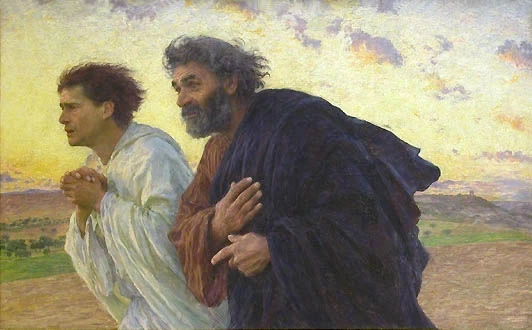Easter Morning - The Disciples at the Tomb
By New Christian Bible Study Staff

In the Easter story, in the Gospel of John, Mary Magdalene comes to the tomb first, on the Sunday morning. She sees that the stone has been rolled away from where it was sealing Jesus's tomb, and that Jesus's body is not there. She runs back with the news, meeting Peter and John on her way.
John and Peter run to the tomb to see for themselves. John arrives first, and looks in, but doesn't go in. Peter arrives, and goes on into the tomb, looking around, seeing the graveclothes and the napkin. The John enters, too, and sees it all, and believes, too, that the Lord has been resurrected.
There are three kinds of "seeing" that are involved in this story - and they are the three kinds, or stages, of seeing that we need to go through. In the Greek text - the original language of the New Testament - there are three separate words used for these kinds of seeing.
Here's the Greek text, along with a very literal (Young's Literal) transation into English:
John 20:4, 5: and the two were running together, and the other disciple did run forward more quickly than Peter, and came first to the tomb, and having stooped down, seeth the linen clothes lying, yet, indeed, he entered not.
John 20:4, 5: ἔτρεχον δὲ οἱ δύο ὁμοῦ· καὶ ὁ ἄλλος μαθητὴς προέδραμεν τάχιον τοῦ Πέτρου καὶ ἦλθεν πρῶτος εἰς τὸ μνημεῖον, καὶ παρακύψας βλέπει κείμενα τὰ ὀθόνια, οὐ μέντοι εἰσῆλθεν.
βλέπει is one kind of seeing. It's an eager, first to arrive, quick assessment kind of seeing.
The second type of seeing is mentioned next, in verses 6 and 7. Look for the Greek word, θεωρεῖ, which means a more analytical, considering, careful studying.
John 20:6, 7: Simon Peter, therefore, cometh, following him, and he entered into the tomb, and beholdeth the linen clothes lying, and the napkin that was upon his head, not lying with the linen clothes, but apart, having been folded up, in one place;
John 20:6, 7: ἔρχεται οὖν καὶ Σίμων Πέτρος ἀκολουθῶν αὐτῷ, καὶ εἰσῆλθεν εἰς τὸ μνημεῖον· καὶ θεωρεῖ τὰ ὀθόνια κείμενα, καὶ τὸ σουδάριον, ὃ ἦν ἐπὶ τῆς κεφαλῆς αὐτοῦ, οὐ μετὰ τῶν ὀθονίων κείμενον ἀλλὰ χωρὶς ἐντετυλιγμένον εἰς ἕνα τόπον.
Then, in verse 8, we see the Greek word εἶδεν, which describes a third kind of seeing; one that is deeper, and sees a whole thing, and that comes before real belief.
John 20:8: then, therefore, entered also the other disciple who came first unto the tomb, and he saw, and did believe;
John 20:8: τότε οὖν εἰσῆλθεν καὶ ὁ ἄλλος μαθητὴς ὁ ἐλθὼν πρῶτος εἰς τὸ μνημεῖον, καὶ εἶδεν καὶ ἐπίστευσεν·
There's a clear progression in the story. We need to make this progression too, in our own spiritual growth - our own Easter morning. We move from the first eagerness to see, followed by a deeper, more careful studying and assessing, and then by reaching a deeper level of insight, understanding, and belief, or faith.






